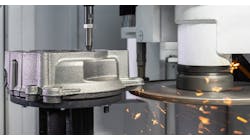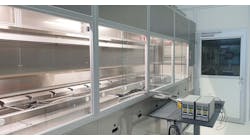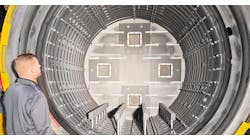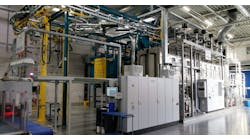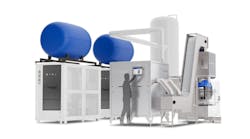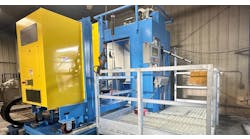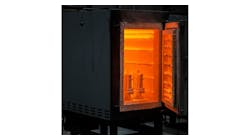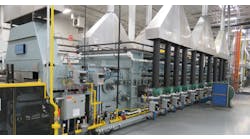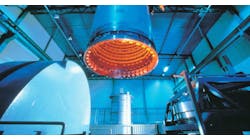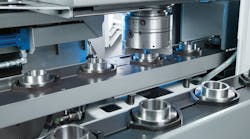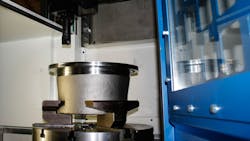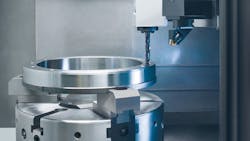Casting metal parts is a design process, fundamentally, but the skill of foundry operators makes it a production program – coordinating and compromising innumerable factors to make those designs into parts that can be profitable. Near the end of the production process, machining becomes a factor, and as the buyers of cast parts specify more quality and precision in their purchases, machining is becoming an even greater part of foundry operators’ decision-making. Selecting the right machine to finish a job is a new challenge for many foundries.
There is design work involved in machining, too, but the primary challenge for foundries is selecting the grinding, turning, or other machining system that complements the value they create in their melting, pouring, and molding operations.
Grinding machine specialist Maus S.r.l. recognizes foundries’ need for customized machining operations, which is one reason it has formed a sales and manufacturing joint venture with Palmer Manufacturing & Supply Inc., to be headquartered at a new plant in Springfield, OH. Palmer Maus N.A. (PMNA) will build, supply, service, and support Maus automatic grinding and vertical turning equipment lines in North American, concentrating on metalcasters, and other manufacturers that finish cast parts.
“This new investment signifies our growth and continued commitment to the North American market,” according to Roberto Sammartin, managing director for Maus. “Having a local presence will allow us to support our customers with top-quality service, sales support, and spare parts management. This new venture reflects our strong belief that our brand has significant growth potential in North America.”
Maus has two product series that address foundries’ machining objectives: automatic grinding machines and vertical turning machines. The first includes a range of machines and technology for automatic grinding parts weighing from 1 to 10,000 kg. Systems can be optimized to a foundry’s production volumes, automated with robotics to maximize process consistence, and integrated with other operations to promote maximum throughput.
Grinding work cells for high volumes of automotive parts are a particular specialty – and one that matches the grinding needs of many foundries.
Maus’ other product series is its MTV vertical turning systems, which further addresses the need for foundries to process high volumes of complex cast parts, as in automotive manufacturing. The series features an “auto changeover” function that coordinates the machining set-up sequence, product handling and placement, and the turning production sequence. In addition to the flexibility inherent in this combination of steps, the MTV series is capable of unmanned production, meaning it’s available for round-the-clock operation (known as “lights out production” in the world of machining.)
MTV series machines are able to process parts with a maximum turning diameter of up to 600 mm, and maximum height of 400 mm. An “auto changeover” feature handles all set-up functions without interrupting production, and automated tool changing takes advantage of a large tool magazine. The developer claims it’s possible to conduct turning, drilling, tapping, milling, broaching, and other steps, all in a single set-up. The developer claims it’s possible to conduct turning, drilling, tapping, milling, broaching, and other steps, all in a single set-up.
The system also incorporates “in-process measurement” to check components and automatically calibrate and compensate settings, to ensure consistent product quality.
According to Maus, the MTV vertical lathes represent a synthesis of design and manufacturing concepts that emphasize reduced Total Cost of Ownership (TCO), meaning investment, operating, and maintenance costs all contribute to foundries’ objective of adding marginal value to the castings they produce.
“Palmer is pleased and honored to be selected by Maus for this joint venture,” offered president Jack Palmer, who added that PMNA also will stock spare parts for the venture’s grinding and vertical turning equipment. Palmer Manufacturing specializes in manufacturing heavy-duty no-bake foundry equipment, including sand mixers, molding systems, core room equipment, sand reclamation, and mold handlers, as well as complete foundry systems and engineering services.
“This will provide customers with a single source for the highest level of long-term local product support,” Palmer added.
Vertical turning has emerged as a particularly effective machining strategy for foundries with high-volume production requirements. Automotive foundries, in particular, need technologies for consistent machining of complex, precision parts.
Another source of vertical lathe systems, EMAG LLC, is set to introduce several new machines later this year. The VM 9 vertical turning center, the latest in the VM series, is designed to machine chucked components with a maximum diameter up to 450 mm. It features a tool turret that can be set-up with twelve tool positions and can be equipped with driven tools to carry out drilling or milling operations. An integrated probe performs continuous quality control, ensuring process reliability.
Also to be introduced soon will be EMAG’s VL series, a “modular inverted vertical lathe design.” The four different machines in the series are compact designs — small-footprint machines are important to plants installing additional capability where extra floor space is not always available — that are adaptable to medium- and large-batch runs. The VL machines also have an integrated automation system for transporting workpieces, which works together with self-loading pick-up spindles to reduce machine cycle times and promote higher throughput.
VL machines are arranged with all systems (electrics, hydraulics, cooling system, cooling lubricant and central lubrication system) easily accessible for operation and maintenance requirements.
For many machining operations, including those at foundries, precision (not high-throughput) is the primary design objective. In shops and plants finishing wheels or hubs, or gears or shafts, the complexity of a design and the appearance of the finished part are essential factors in the selection of a cutting, turning, or grinding machine.
The Präwema SynchroFine 205 HS gear-honing machine, now available from German Machine Tools of America, has a direct-drive, digitally controlled spindle design that achieves precise, rigid synchronization for the tool and the workpiece. The supplier maintains that the Präwema Honing gear finishing process produces quality comparable to grinding for spur and helical gears, as well as shafts.
Part of the machine’s precision is software-based, with programming that checks the stock allowance and workpiece run-out, and then optimizes the X-axis approach distance. Measuring the workpiece does not affect the cycle time and that process can reduce cycle times overall by 3 to 5 seconds, according to GMTA.
The machine features a pick-up design that addresses many operations’ desire for automating machining or finishing. The workpieces and dressing tools are loaded and unloaded by the workpiece spindle. The large X-axis travel enables placement of additional stations adjacent to the loading/unloading station inside the machine, such as a two-flank roll-checking device. Robots and conveyor systems can be integrated to the operation.
GMTA builds the machine on a natural granite bed to promote stability and control thermal fluctuations. The X and Z axes are equipped with linear motor drives. The cutting tool is clamped with a hydraulically operated system and the tool spindle can be swiveled into a vertical position, enabling easy access.
The Präwema SynchroFine 205 HS-D model, equipped with two spindles, is offered for further reduction of cycle times. And, the developer offers additional options for machining oversized drive shafts up to 850 mm long.
Machining cast parts is not the sort of design problem that metalcasting operations may be accustomed to solving, but selecting the right technology to maintain their manufacturing objects – and enhance the quality of the castings they produce — is a new parameter for demonstrating their proficiency.
